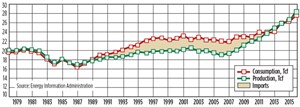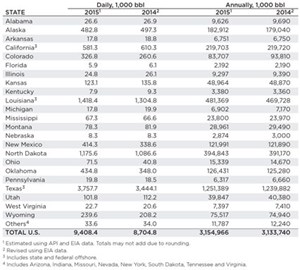Production reaches new highs, but prices will curtail output
Crude oil. Overall, U.S. crude oil production increased slightly in 2015, with noticeable gains reported in the Bakken and Eagle Ford/Permian shale plays of North Dakota and Texas, respectively. Crude oil prices started the year at around $45/bbl, then rose steadily, hitting a yearly high in the $60–65/bbl range during May and June. During the second half of the year, crude prices started a steep decline, bottoming in December at seven-year lows of approximately $33.50/bbl.
As oil prices continued to fall, U.S. production showed signs of slowing, posting only a modest gain for 2015, of just 8%, with daily average production reaching 9.4 MMbpd. This compares to an 8.7-MMbopd average in 2014. The low prices have caused large operators to slash exploration/development budgets for 2016, and have forced service providers and producers to significantly reduce employee head counts, especially in the U.S.
Among the 23 major oil-producing states, losers outnumbered gainers. However, the large shale plays continued to gush crude at record levels despite the nationwide drilling slowdown, as oil wells in these regions proved more resilient than expected. Among the gainers, Texas easily held its position as North America’s largest oil-producing state, hitting an average of 3.7 MMbpd in 2015, up 9% from the year before. Louisiana’s on- and offshore activity kept the state in second place among domestic oil producers, managing a 9% increase over 2014’s level, rising to 1.4 MMbpd.
North Dakota’s Bakken play reported an 8% increase, producing 1.2 MMbopd in 2015, compared to 1.1 MMbopd in 2014. Activity in the Niobrara shale play resulted in a 66,000 bopd gain in Colorado, as that state’s capability reached 327,000 bopd. Wyoming posted a 15% gain, to 240,000 bopd. New Mexico also posted a 22% increase, up to 414,000 bopd. Two other oil-producing states saw significant percentage gains, including Oklahoma (up 25% to 435,000 bopd) and Ohio, which led the nation in percentage increase at 75%. Its daily production reached 71,500 bopd. Among the losers, California’s daily crude rate dipped 5%, to 581,300 bopd, with Alaska losing 3% of its daily capacity, down to 482,800 bopd.
Natural gas. Prices for natural gas remained relatively stable during the first three quarters of 2015, hovering around $2.80/Mcf. However, in October, prices at the Henry Hub started a downward spiral, ending the year at $1.87/Mcf. Natural gas production continued to grow, averaging 79.1 Bcfd. This rate kept pace with increased consumption, which reached a daily average of 75.4 Bcfd in 2015. A small shift back to drilling natural gas prospects in 2016 is expected to keep pace with demand. ![]()

- What's new in production (February 2024)
- Prices and governmental policies combine to stymie Canadian upstream growth (February 2024)
- U.S. operators reduce activity as crude prices plunge (February 2024)
- U.S. producing gas wells increase despite low prices (February 2024)
- U.S. drilling: More of the same expected (February 2024)
- U.S. oil and natural gas production hits record highs (February 2024)




